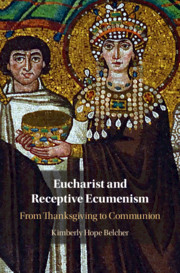Book contents
- Eucharist and Receptive Ecumenism
- Eucharist and Receptive Ecumenism
- Copyright page
- Contents
- Tables
- Preface
- Acknowledgments
- 1 The Call of Unity
- 2 Diversity Is the Tradition
- 3 A Phenomenology of Giving Thanks
- 4 Eucharistia and Revelation
- 5 Ambrose’s Words and the Roman Canon
- 6 Augustine and the Assembly’s Destiny
- 7 Consecrating and Offering the Ordinary
- 8 The Eschatological Exception
- 9 Outdo One Another in Showing Honor
- 10 Into the Heart of God
- Bibliography
- Index
2 - Diversity Is the Tradition
Published online by Cambridge University Press: 16 October 2020
- Eucharist and Receptive Ecumenism
- Eucharist and Receptive Ecumenism
- Copyright page
- Contents
- Tables
- Preface
- Acknowledgments
- 1 The Call of Unity
- 2 Diversity Is the Tradition
- 3 A Phenomenology of Giving Thanks
- 4 Eucharistia and Revelation
- 5 Ambrose’s Words and the Roman Canon
- 6 Augustine and the Assembly’s Destiny
- 7 Consecrating and Offering the Ordinary
- 8 The Eschatological Exception
- 9 Outdo One Another in Showing Honor
- 10 Into the Heart of God
- Bibliography
- Index
Summary
The purpose of this chapter is not to provide a historical account of the development of eucharistic theology or eucharistic liturgy. There are legions of such accounts, and more excellent ones than time.1 Rather, its purpose is to look over these histories with an ecumenical and constructive eye. The ecumenical eye considers historical development not as a monochromatic tragedy or a divinely ordained triumph but rather as the consequence of decisions made by Christians trying to faithfully explicate, using the intellectual and cultural resources of their time, the mysteries of faith. The constructive eye considers how to retain the rich diversity of early Christian eucharistic theology even as it embraces the neutral and positive contributions of various narrower scholastic and post-Reformation approaches. Whereas following the Reformation many retrievals were weaponized to bolster narrow polemical theologies, this approach to our history seeks to use historical narrative to “bind the wounds” persisting from centuries of schism and distrust.2
- Type
- Chapter
- Information
- Eucharist and Receptive EcumenismFrom Thanksgiving to Communion, pp. 28 - 53Publisher: Cambridge University PressPrint publication year: 2020

